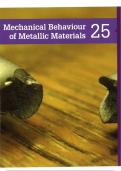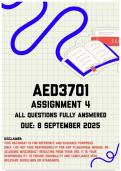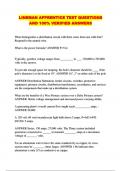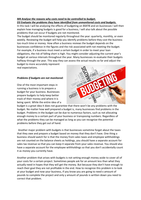AJJeffr.-.,e~ engineering. This unit considers the mechanical characteristics of
This u~it will be metals. It will help explain why metals are so versatile and how they
~ssessed
by ~ series of can be tailored to suit particular applications by combining them in
alloys and applying heat treatment processes. Of course, even the
~ss~~me~s set by your
strongest materials have their limits. Understanding the mechanisms
tutor. by which metals fail is important for all engineers if they are to use and
apply metallic materials safely. In this unit you will measure properties
such as hardness and tensile strength using testing equipment and
investigate in-service failures.
How you will be assessed
This unit will be assessed by a series of internally assessed tasks set by your tutor.
Throughout this unit you will find assessment practice activities to help you work
towards your assessment. Completing these activities will mean that you have carried
out useful research or preparation that will be relevant when it comes to your final
assignment.
In order for you to complete the tasks in your assignments, it is important to check
that you have met all of the Pass assessment criteria. You can do this as you work your
way through each assignment.
If you are hoping to gain a Merit or Distinction grade, you should also make sure that
you present the information in your assignment in the style that is required by the
relevant assessment criterion. For example, Merit criteria require you to analyse and
discuss, and Distinction criteria require you to assess and evaluate.
The assignments set by your tutor will consist of a number of tasks designed to meet
the criteria in the table. They are likely to take the form of written reports, but may
also include activities such as the following:
~ Carrying out destructive test procedures on a range of metallic samples.
~ Carrying out non-destructive test procedures on a range of metallic samples.
~ Analysing case studies and assessing physical evidence to investigate in-service
component failure.
420 Mechanical Behaviour of Metallic Materials
, Getting to know your unit UNIT 25
Assessment criteria
This table shows what you must do in order to achieve a Pass, Merit or Distinction grade, and where
you can find activities to help you.
Pass Merit Distinction
El
•.,.
Leaming aim Investigate the microstructure of metallic materials and the
.,.,,
effects of processing on them and how these effects influence
their mechanical properties
Explain how the microstructure of non- Analyse, using an accredited data source, Evaluate, using an accredited data
.,.
processed metallic materials affects the the microstructure of non-processed and source, the microstructure of non-
mechanical properties of the material. processed metallic materials to correctly processed and processed metallic
Assessment practice 25.1 identify the material, including how the materials to identify the material,
processing history affects the mechanical including how the processing history,
properties of the materials. impurities and grain boundaries affect
Explain how the microstructure of Assessment practice 25.1 the mechanical properties of the
processed metallic materials affects the materials.
mechanical properties of the material. Assessment practice 25.1
Assessment practice 25.1
Leaming aim Ill Explore safely the mechanical properties of metallic materials
and the impact on their in-service requirements
i :l@M
Conduct destructive tests safely on
l:l~1fl
Conduct destructive and non -destructive
•=
•·>•
Evaluate, using the results from safely
different non-processed and processed tests accurately on different non- conducted tests and an accredited data
metallic samples. processed and processed metallic samples. source, how the mechanical properties
Assessment practice 25.2 Assessment practice 25.2 of processed and non-processed
metallic materials affect their behaviour
i :l:Zi and suitability for different realistic
Conduct non-destructive tests safely applications, justifying the validity of the
on at least two non-processed and test methods used.
processed metallic samples. Assessment practice 25.2
Assessment practice 25.2
i :IJW l :l®il
Explain, using the test results, how Analyse, using the test results and
the mechanical properties of metallic an accredited data source, how the
materials affect their behaviour and mechanical properties of metallic
suggest an application . materials affect their behaviour and
Assessment practice 25.2 suggest a realistic application.
m Assessment practice 25.2
Leaming aim Explore the in-service failure of metallic components and
consider improvements to their design
Conduct a visual inspection check and at Conduct a visual inspection check and
...,.
Evaluate, using language that is
.,.
least one test safely on components that at least one test safely and accurately on technically correct and of a high
have failed in service. components that have failed in service. standard, the results from safely
Assessment practice 25.3 Assessment practice 25.3 conducted and accurate checks and tests
to establish how components failed in
service, recommending a design solution
Explain, using the results, how each Analyse, using the results, how each from a range of alternatives.
component failed and how each component failed and justify how each Assessment practice 25.3
component's design could be improved. component's design could be improved.
Assessment practice 25.3 Assessment practice 25.3
42"
, Getting started
Work in a small group to describe all the properties that you associate with
metallic materials. When you have come up with at least eight properties
between you, go on to identify an engineered product or an engineering
process where each of the properties you have identified is important.
I Investigate the microstructures of metallic materials and
the effects of processing on them and how these effects
influence their mechanical properties
The physical properties of a metallic material are a Alloy steels
consequence of the metallic bonds that hold the atoms
An enormous range of additional alloying elements
together in a regular crystal structure. It is important for are utilised in small amounts to further enhance the
engineers to understand these structures and how they can
mechanical properties of steel.
be manipulated using alloying or heat treatment techniques.
Structural steel
A1 Types of ferrous metals and alloys Grade S275JR is a typical hot-rolled steel used in welded,
bolted and riveted structural applications.
By definition, ferrous metals contain the metallic element
It contains 0.21% carbon, 1.5% manganese, 0.55% copper,
iron {Fe). Pure iron is relatively soft and malleable and as such
0.04% sulphur and 0.04% phosphorous.
is unsuitable for many engineering applications. However,
when alloyed with other elements, notably carbon, the Tool steel
characteristics of the material can be transformed . Grade 01 is a typical carbon-manganese hardenable tool
steel used in a range of applications, including press tools,
Plain carbon steel marking punches, taps and knife blades.
Steel is a general term used for a range of metal alloys It contains 0.95% carbon, 1.25% manganese, 0.50%
containing iron and 0.08-1.2% carbon by weight. As chromium, 0.50% tungsten and 0.20% vanadium.
the carbon content of the alloy increases, so does the
Stainless steel
strength and hardness of the steel. However, there is
a corresponding reduction in toughness and ductility. Grade 304 is a typical stainless steel in the UK.
Table 25.1 lists the carbon content of plain carbon steels, It contains 0.08% carbon, 2.00% manganese, 18.00%
as well as wrought iron and cast iron. chromium, 8.00% nickel, 0.045% phosphorous, 0.03%
sulphur and 0.75% silicon.
Key term )
Heat-resistant steel
Alloy - a mixture of two or more metals which has Certain alloying metals such as molybdenum confer
enhanced mechanical properties or corrosion resistance heat-resistant properties so that the steel maintains its
compared with the pure metal used alone. key mechanical properties such as strength and creep
resistance, even when operating at elevated
~ Table 25.1 Plain carbon steels, wrought iron and cast iron temperatures.
Material _______,
Carbon content
Link
Wrou ht iron Less than 0.08%
Low-carbon st_ee_l _ __ __u.P to 0.~ For more details about ductility, tensile strength and
Mild steel Between 0.15% and 0.35%
hardness, see Section A3. For more details about heat
Medium-carbon steel Between 0.35% and 0.6%
treatment, see Section AS. For more details about creep
High-carbon steel Between 0.6% and 1.2%
failure, see Section C2.
Cast iron Between 1.4% and 4%
-------
l22 Mechanical Behaviour of Metallic Materials






